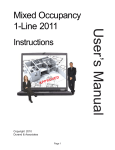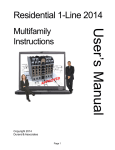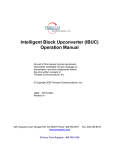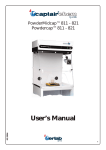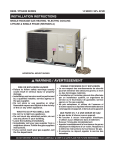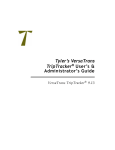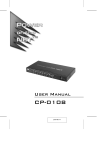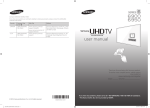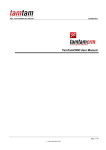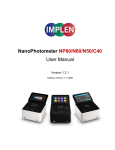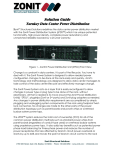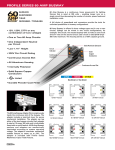Download User`s Manual - Durand & Associates
Transcript
1-Line 2014 P AP R E OV D Copyright 2013 Durand & Associates Page 1 User’s Manual Load Calculation Software 1-LINE 2014 COPYRIGHT 2013 - DURAND & ASSOCIATES This software and manual are protected by Federal Copyright Laws and may not be copied or duplicated for the purpose of resale or distribution. A registered user may copy the template files for their own personal use provided they retain sole possession of such copies. The 1-Line 2014 software is a spreadsheet template software program for calculating main service switchboard, subpanels, feeder sizes and 1-Line drawings. This program may be used for industrial and commercial loads. The 1-Line 2014 software is for reference purposes only, and Durand & Associates cannot assume any responsibility for the accuracy of the program contents. In using this program the user agrees to hold harmless and wave all claims against Durand & Associates. SOFTWARE REQUIREMENTS 1-Line 2014 was created with Microsoft Excel 97. To use these templates you must have Microsoft Excel, Version 97 or later, installed on your computer. If you are using Excel 2007 or later please use the 1-Line folder C:\1-Line 2014 Excel 2007 Page 2 INTRODUCTION The 1-Line 2014 software is a spreadsheet template program. The program was designed for use in conjunction with Microsoft Excel on the Windows platform. The program should also work on other platforms that can read and write Microsoft Excel 97 file formats. LOADING THE PROGRAM Insert the CD in your drive and follow the setup instructions. The installation of 1-Line will create the following folder on your C drive. C:\1-Line 2014 EXPLORING THE PROGRAM 1-Line software is a complex spreadsheet template program. The program uses 53 files which link to one another. DO NOT CHANGE THE FILE NAMES. If a file name is changed the template can become corrupt. Page 3 LOCATING THE PROGRAM FILES The 1-Line templates are located on your C: drive. 1-Line 2014 Folder If you double click on the 1-Line folder, you will find 1 folder. Blank Folder Page 4 STARTING A NEW PROJECT If you want to start a new project, RIGHT CLICK on the blank folder and select COPY. Then RIGHT CLICK on the white area of the window and select PASTE. This will create a new folder titled “Copy of Blank”. Page 5 RENAME THE FOLDER You can RIGHT CLICK on the new folder and select the RENAME command. Type in your new project name. Use this method to create a new project each time you start a new 1-Line. Now that you have created a new folder close all windows. Page 6 USING THE PROGRAM Go to your START MENU, select ALL PROGRAMS, and select EXCEL. This will start your Excel spreadsheet program. TURNING ON AUTOMATIC UPDATING IN EXCEL Go to the Tools menu and select Options Page 7 TURNING ON AUTOMATIC UPDATING IN EXCEL (Continued) Go to the Tools menu and select Options Select the Edit Tab Uncheck the “Ask to update automatic links.” Page 8 USING THE PROGRAM Select the FILE OPEN command and locate the 1-Line 2014 folder on your C: drive. Double click the 1-Line 2014 folder to display the contents. Now displayed are two folders. 1. Blank 2. Your New Project (This is the folder you just created.) Page 9 EXPLORING THE SAMPLE PROJECT Double click on the YOUR NEW FOLDER to display the contents. The files in this folder are MSWBD, P1-P24, X1-X24, and MCC 1-4. MSWBD ( Main Switchboard) P1 - P24 (Panels) X1 - X24 (Transformer/Panels) MCC 1-4 (Motor Control Centers) DO NOT RENAME THESE FILES (This will corrupt the files). Page 10 WORKING WITH THE MAIN SWITCHBOARD (MSWBD) Double click on the MSWBD file to display the Main Switchboard Template. This may take a few seconds to open as Excel updates the links to the Panel files. GENERAL INFORMATION - Code Year (Select 2002, 2005, 2008, 2011 or 2014) - Panel Name (Enter the name of the Main Switchboard) - Fed From (Enter the power source for the Main Switchboard) - # Of Circuits (Enter the number of Panels 1-24) - High Voltage (Enter high voltage) - Low Voltage (Enter low voltage) - Phase (Select the phase from the pulldown menu) 1 = 1-Phase 3D = 3-Phase Delta 3Y = 3-Phase Wye - Hi-Leg Size (Select size from pulldown menu) This option only appears when using a 3-phase delta service. If you select AUTO, the program will size the L2 (Hi-Leg) to the load. If you select FULL, the program will size L2 the same as L1 & L3. - Neutral Size (Select size from pulldown menu) When MINIMUM is selected, the line to neutral load must be identified with an (N) in the panel templates. - Hertz (Enter Hertz) - Minimum Amps (Enter the minimum amps) The minimum amps is the smallest size allowed for the service. If the load exceeds the minimum amps, the program will automatically size the service to the correct size. Page 11 GENERAL INFORMATION (continued) - Minimum Amps L2 (Enter the minimum amps for L2) This option only appears when using a 3-phase delta service and when AUTO is selected for L2 (Hi-Leg). If the load exceeds the minimum amps, the program will automatically size L2 to the correct size. - Minimum Neutral Amps (Enter the minimum neutral amps) This option only appears when AUTO is selected for neutral size. If the load exceeds the minimum amps, the program will automatically size the neutral to the correct size. - % Factor (Enter percent factor) This factor is used two ways. If you enter 20%, the ampacity of the panel and conductors will be increased 20%. You can also use this factor to correct for voltage drop. - % Factor L2 (Enter percent factor for L2) This option only appears when using a 3-phase delta service and when AUTO is selected for L2 (Hi-Leg). This factor is used two ways. If you enter 20%, the ampacity of the L2 conductor will be increased 20%. You can also use this factor to correct for voltage drop. - Main Breaker Sizing (Select method) AUTO Program will automatically size main breaker and feeder conductors. When load exceeds 1200 amps, the MANUAL method must be used. MANUAL You enter the conductor and conduit size. NONE If you have seven (7) or more circuits, you must have a main breaker. - Main Breaker Amps (Enter amps) This option only appears when the main breaker sizing is set for MANUAL - Main Breaker Position (Select position) This option only appears when a main breaker is used. DISPLAY OPTIONS - Show Meter (Yes/No) If YES is selected, a meter will appear on the 1-Line drawing. - Show Current Transformer (Yes/No) If YES is selected, a CT will appear on the 1-Line drawing. - Show Fault Current (Yes/No) If YES is selected, fault current will appear on the 1-Line drawing. Page 12 DISPLAY OPTIONS (continued) - Show Voltage Drop (Yes/No) If YES is selected, voltage drop % will appear on the 1-Line drawing. - Show Conduit Length (Yes/No) If YES is selected, conduit length will appear on the 1-Line drawing. - Show Ufer Ground (Yes/No) If YES is selected, Ufer ground will appear on the 1-Line drawing. - Show True Phase Connection (Yes/No) If YES is selected, directories and panel schedules will display actual phase. SERVICE ENTRANCE FEEDER OPTIONS (AUTO) When AUTO is selected, the following will be displayed. - Service Feeder Sizing (Select Method) AUTO Program will automatically size service entrance conductors. When load exceeds 1200 amps, the MANUAL method must be used. MANUAL You enter the conductor and conduit sizes. NONE No service entrance conductors will be shown. - Wire Type (Select Type) - Wire CU/AL (Select Type) - Wire Temp C (Select Temp) - Wire Length (Enter Wire Length) - Conduit Type (Select Conduit Type) - Overhead/Underground (Select Method) Page 13 SERVICE ENTRANCE FEEDER OPTIONS (MANUAL & CONDUIT) When MANUAL and CONDUIT are selected the following will be displayed. - Overhead/Underground (Select Method) - Conduit/Busway (Select Method) - Conduit Length (Enter Conduit Length) - Conduit Size (Select Size) - Wire CU/AL (Select Type) - Wire Type (Select Type) - Wire Size (Select Size) - Wire Size (Hi-Leg) L2 (Select Size) This option only appears in the 3-Phase Delta Mode. - Neutral Size (Select Size) - Conduit Type (Select Type) - Number of Conduits (Enter Number) Page 14 SERVICE ENTRANCE FEEDER OPTIONS (MANUAL & BUSWAY) When MANUAL and BUSWAY are selected the following will be displayed. - Overhead/Underground (Select Method) - Conduit/Busway (Select Method) - Busway Length (Enter Busway Length) - Busway Size (Select Size) - Busway CU/AL (Select Type) FAULT CURRENT CALCULATIONS (NONE) - Select Method (Select Method) Page 15 FAULT CURRENT CALCULATIONS (UTILITY TRANSFORMER INFINITE BUS) Use this method when the Available Fault Current is not known and the transformer KVA is known. - Select Method (Select Method) - Utility Voltage Adjustment (Enter 1.0 or 1.1) - Transformer KVA (Enter KVA) - Transformer % Z Rating (Enter Rating) FAULT CURRENT CALCULATIONS (TRANSFORMER KNOWN AFC) Use this method when the primary fault current is known and the transformer KVA is known. - Select Method (Select Method) - Available Fault Current (Enter AFC) - Utility Voltage Adjustment (Enter 1.0 or 1.1) - Transformer KVA (Enter KVA) - Transformer % Z Rating (Enter Rating) - Primary Voltage (Enter Voltage) Page 16 FAULT CURRENT CALCULATIONS (NO TRANSFORMER KNOWN AFC) This is the most common method and should be used in most projects. Use this method when the utility provides the Available Fault Current. Even if there is a utility transformer, most utilities will give you the fault current on the secondary side and you should use this method. - Select Method (Select Method) - Available Fault Current (Enter AFC) - Utility Voltage Adjustment (Enter 1.0 or 1.1) AUTOMATIC TRANSFER SWITCH & ENGINE GENERATOR - Auto Transfer Switch (Select Yes or No) - Size of Transfer Switch (Enter Amps) - ATS Distance from MSWBD (Enter Distance in Feet) - Engine Generator (Select Yes or No) - Generator Sizing (Select Manual or Auto) - KW of Generator (Enter KW) - Genset Distance from ATS (Enter Distance in Feet) Page 17 IDENTIFY CIRCUIT LOADS Use the pulldown menu to identify your circuit loads. - Panel When you choose Panel, all load calculations forward from the Panel Template. - Xmfr When you choose Xmfr, all load calculations forward from the Xmfr Panel Template. - Space When you choose Space, a space is shown on the 1-Line. - Spare When you choose Spare a spare circuit breaker is shown on the 1-Line. - Manual When you choose Manual, you may input manual load on the M-Loads tab and the M-Feeders tab. - MCC May be selected for the first four (4) circuits. C1, C2, C3, or C4 When you choose MCC, all load alculations forward from the Motor Control Center Template. SPARE or SPACE AMPS When you select SPARE or SPACE, you need to select the amp rating for each. Page 18 IDENTIFY CIRCUIT LOADS - WITH METERS SHOWN Use the pulldown menu to identify your circuit loads with meters. - Panel w/m When you choose Panel w/m, all load calculations forward from the Panel Template. - Xmfr w/m When you choose Xmfr w/m, all load calculations forward from the Xmfr Panel Template. - Space w/m When you choose Space w/m, a space is shown on the 1-Line. - Spare w/m When you choose Spare w/m a spare circuit breaker is shown on the 1-Line. - Manual w/m When you choose Manual w/m, you may input manual load on the M-Loads tab and the M-Feeders tab. - MCC May be selected for the first four (4) circuits. C1, C2, C3, or C4 When you choose MCC w/m, all load alculations forward from the Motor Control Center Template. Page 19 IDENTIFY OVERCURRENT DEVICE Use the pulldown menu to identify your overcurrent device - Breaker - Fuse Page 20 MANUAL LOADS If you select MANUAL, you may enter the load and feeder information on the M Load tab and the M Feeder tab. M Load Tab M Feeder Tab Page 21 LINKED FILES The MSWBD file and all Panel files are linked back and forth. File links are only updated when the files are open. If the file is closed and information is change, the closed file will not update formula calculations. When this happens a link update color of orange will appear on your MSWBD template. Example To avoid this you may want to open all active files. (SEE NEXT PAGE) Page 22 OPENING MORE THAN ONE FILE Let’s say you have a main switchboard and 6 panels. 1. Start your Excel program. 2. Select Open 3. When the files appear, use the mouse to select the MSWBD files and P1-P6 files. 4. Then click on OPEN. When these files are open, all linked formulas will update automatically. Page 23 PRINTING LOAD CALCS If you want to print the load calculations, click on the CALCS tab and use the FILE and PRINT command. PRINTING THE 1-LINE If you want to print the 1-Line calculations, click on the 1-LINE tab and use the FILE and PRINT command. You may want to use the PRINT PREVIEW command to make sure the 1-Line fits on the page. If it prints on more than one page, you may have to adjust the percentage (%) under PAGE SETUP. NOTE: The 1-Line printout may produce additional blank pages. CREATING PDF FILES If you wish to create PDF files of printouts, you will need to have Adobe Acrobat. If you have Adobe Acrobat, a Create Adobe PDF command appears under the FILE menu. Page 24 USING THE PANEL TEMPLATES There are 24 panel templates P1 through P24. Do not change the name of these files. Each file links to the MSWBD file and forwards all the load calculations. The panel files also read information from the MSWBD files. It is best to have the MSWBD file open when working with the panel files. USING THE TABS The template has twelve (12) tabs. The first five tabs are for the Panel and the second five tabs are for the Subpanel. Each tab has a special purpose: Panel Tabs Input - This sheet is used to enter information. Schedule - This sheet is used to review and print the panel schedule. Calcs - This sheet is used to review and print load calculations. Directory - This sheet is used to review and print the circuit directory. Errors - This sheet is used to review and print the errors. Subpanel Tabs S-Input - This sheet is used to enter information. S-Schedule - This sheet is used to review and print the panel schedule. S-Calcs - This sheet is used to review and print load calculations. S-Directory - This sheet is used to review and print the circuit directory. S-Errors - This sheet is used to review and print the errors. Misc Tabs Copy/Paste - This sheet explains the Paste Values command for Excel. CAD - This sheet explains how to use the Copy Picture command and paste into a CAD program. Page 25 USING THE XMFR PANEL TEMPLATES There are 24 XMFR panel templates X1 through X24 do not change the name of these files. Each file links to the MSWBD file and forwards all the load calculations. The XMFR panel files also read information from the MSWBD files. It is best to have the MSWBD file open when working with the XMFR panel files. USING THE TABS The template has twelve (12) tabs. The first five tabs are for the Panel and the second seven tabs are for the Subpanel Each tab has a special purpose: Subpanel Tabs S-Input - This sheet is used to enter information. S-Schedule - This sheet is used to review and print the subpanel schedule. S-Calcs - This sheet is used to review and print subpanel load calculations. S-Directory - This sheet is used to review and print the subpanel circuit directory. S-Errors - This sheet is used to review and print the subpanel errors. Misc Tabs Copy/Paste - This sheet explains the Paste Values command for Excel. CAD - This sheet explains how to use the Copy Picture command and paste into a CAD program. Page 26 GENERAL ENTRIES Some cells in the template files are protected. You may only enter information into certain cells. If you are using a color monitor, these cells are yellow or lime green. Yellow Cells Lime Green Cells Each unprotected yellow cell requires a user entry. If an invalid entry is made, a RED error message will appear to the left of the entry or an error message will appear in a pop up box. When you select a cell a hint box will appear. You may also use the pulldown menu. Page 27 GENERAL ENTRIES (continued) Below is a list of valid entries for the general information section of the panel schedule. PANEL Enter the panel name such as LPA. If entry is too long it may be cut off when printed. (As a general rule 22 characters are allowed.) P1 # OF CIRCUITS 30 Enter number of circuits. (Even number from 6 to 84) or use the pulldown menu. PHASE 3Y Enter phase. Note: You may put a 1-Phase panel on a 3-Phase source. HI-LEG SIZE AUTO Select Auto or Full. (3-Phase Delta Only) NEUTRAL SIZE AUTO Select Auto or Full Most of the time you will select Full and the neutral conductor will be sized the same as the line conductor. If you select auto you must identify each line to neutral circuit with a (N) on the panel schedule. MIN NET AMPS 60 You may enter zero and the program will calculate the proper wire size. You may also enter a minimum value and the program will use the minimum value. If the minimum value is less than the neutral load, the program will size the neutral to handle the neutral load. The program will size the neutral to carry at least 34 percent of the line conductors per NEC requirements. GND WIRE Y/N Y Enter Y or N. If you enter Y, an equipment ground conductor will be added to the feeder conduit(s). WIRE TYPE THHN Select the wire type. WIRE CU/AL? CU Enter CU or AL. WIRE TEMP 75 Enter the wire insulation temperature. Page 28 GENERAL ENTRIES (continued) Enter wire length. WIRE LENGTH 20 CONDUIT TYPE EMT Select conduit type. MINIMUM AMPS 100 Enter minimum amps. If the load exceeds the minimum amps, the program will automatically size the wire for Code requirements. MINIMUM AMPS (L2) 100 Enter minimum amps for hi-leg (L2). If the load exceeds the minimum amps, the program will automatically size the wire per Code. KITCHEN LOADS 5 Enter the number of kitchen loads. % FACTOR 20 Enter percentage factor. Example: If you enter 20, the program will provide 20% spare capacity for future loads. You may also use this factor to adjust for voltage drop. % FACTOR (L2) 20 Enter percentage factor for hi-leg (L2). Example: If you enter 20, the program will provide 20% spare capacity for future loads. You may also use this factor to adjust for voltage drop. MAIN BKR / FUSE Y Enter Y or N. If you enter Y, the program will size the main breaker. If this is a 3-phase delta panel with a reduced size hi-leg (L2), the program will size overcurrent protection using fuses. SUB PANEL BKR 3-PHASE BREAKER POSITION 1, 3. 5 Select choice from pulldown menu. If you want a subpanel fed from this panel, select 1-Phase or 3-Phase. If you have a subpanel, select the breaker position from the pulldown menu. Page 29 GENERAL ENTRIES (continued) SHOW VD CALCS YES If you want voltage drop calculations to appear on the load calculation printout enter YES. You may enter any information in the green cells and it will appear on the panel schedule. DISPLAY ONLY Also, in the general information section there are a group of cells displaying wire and conduit size information. These cells only display information when no errors are present in the template. CIRCUIT ENTRIES Once you have completed the general entries, you may begin making the circuit entries. Each circuit entry consists of the following: BREAKER Enter breaker type. CIRCUIT DESCRIPTION Enter circuit description. Page 30 CIRCUIT ENTRIES (continued) 3-PHASE DELTA CIRCUITS If you are entering 1-phase (line to neutral loads) on a 3-phase delta panel, do not put them in the orange cells. Hi-Leg (L2) No 1-phase (line to neutral) loads. LOAD IDENTIFIERS H (HARMONIC LOAD) On 3-phase wye panels, loads subject to harmonic currents (such as electronic ballast and computer equipment) must be identified by placing an “H” in the harmonic identifier column. Enter “H” or a space (Space Bar) HOW THE PROGRAM CALCULATES HARMONIC LOADS. When the harmonic load is 50% or more of the load ( on 3-phase wye panels), the, NEC requires the neutral conductor to be considered a current carrying conductor. Therefore, the feeder conduit has four (4) current carrying conductors and the conductor ampacity must be derated to 80%. The program does this automatically. Page 31 LOAD IDENTIFIERS (continued) NEUTRAL LOADS If you have selected AUTO for neutral sizing, the program will calculate the neutral load and size the neutral separate from the line conductors. This is known as reduced neutral sizing. For this to work properly you need to identify each line to neutral load in the panel. Enter “N” or a space (Space Bar), HOW THE PROGRAM CALCULATES NEUTRAL CONDUCTOR SIZE In the auto sizing mode the largest line to neutral load is the ampacity used. The neutral conductor is sized on that load or 34% of line conductor ampacity per Code requirements. CIRCUIT LOAD IDENTIFIERS There are several ways to identify loads. Listed below are the options. G - General Load D - Receptacle Load (Diversity) C - Continuous Load K - Kitchen Load M - Motor Load Enter ( G, D, C, K, or M ) Page 32 ENTERING CIRCUIT LOADS LINE TO NEUTRAL LOADS (1-Pole Breaker) Enter the VA (Volts X Amps) into the cell. LINE TO LINE LOADS (2-Pole Breaker) Enter one half of the VA in each cell. Example: (50 Amps X 240 Volts) = 12,000 VA (12,000 VA ÷ 2) = 6,000 VA in each cell LINE TO LINE LOADS (3-Pole Breaker) Enter one third of the VA in each cell. Example: (40 Amps X 208 Volts X 1.732) = 14,410 VA (14,410 VA ÷ 3 ) = 4,803 VA in each cell Page 33 SUBPANEL GENERAL ENTRIES FED FROM Select Choice P1 If you select a transformer, you can select the KVA rating or select AUTO and the program will size the transformer automatically. KVA VD ADJUSTMENT 10 If you are using a transformer, a voltage drop adjustment appears. Use this rather than % Factor to adjust for voltage drop. XMFR % Z RATING 10 If you are using a transformer, a transformer % Z rating appears. Enter the % Z rating of the transformer. Page 34 PRINTOUTS Each panel schedule template is designed to print out four (4) sheets for the panel and four (4) sheets for the subpanel. - Panel Schedule Load Calculation Directory Error Checking Report Using the mouse, click on the tab to display the sheet you wish to print. When the sheet is displayed, use the FILE/PRINT command. NO COPY/PASTE Do not use the COPY and PASTE commands on this template as they can corrupt the file. Each cell in this template has been formatted with error checking and performance codes. When you copy a cell and use the paste command, these formats and performance codes are pasted to the new location. PASTE SPECIAL (Values Only) To avoid corrupting the file use the COPY and the EDIT/PASTE SPECIAL command selecting VALUES from the paste special menu. Click on “Values” and click OK. Page 35 USING THE MOTOR CONTROL CENTER TEMPLATES There are 4 MCC templates MCC-1 through MCC-4. Do not change the name of these files. Each file links to the MSWBD file and forwards all the load calculations. The MCC files also read information from the MSWBD files. It is best to have the MSWBD file open when working with the MCC files. USING THE TABS The template has five (5) tabs. Each tab has a special purpose: Panel Tabs Input - This sheet is used to enter information. Calcs - This sheet is used to review and print load calculations. AFC Calcs - This sheet is used to review and print the fault current calculations. VD Calcs - This sheet is used to review and print the voltage drop calculations. MCC 1-Line - This sheet is used to review and print the MCC 1-Line. Page 36 GENERAL INFORMATION - MCC Name (Enter the name of the MCC) - Fed From (Enter the power source for the MCC) - # Of Circuits (Enter the number of circuits 1-20) - Phase (Select the phase from the pulldown menu) 1 = 1-Phase 3D = 3-Phase Delta 3Y = 3-Phase Wye - Minimum Amps (Enter the minimum amps) The minimum amps is the smallest size allowed for the service. If the load exceeds the minimum amps, the program will automatically size the service to the correct size. - Ground Wire (Select YES or NO) - Wire Type (Select wire type) - Wire CU/AL (Select CU or AL) - Wire Temp C (Select 60, 75, or 90) - Wire Length (Enter the length of the wire) - Conduit Type (Select conduit type) - % Factor (Enter percent factor) This factor is used two ways. If you enter 20%, the ampacity of the MCC and conductors will be increased 20%. You can also use this factor to correct for voltage drop. - Main Disconnect (Select BREAKER, FUSED SWITCH, or NON-FUSED SWITCH) Page 37 MOTOR INFORMATION Enter motor description. Enter Conduit Length. Select Phase. Select Conduit Type. Select Wire Type. Select Motor HP. Select CU or AL. END OF USER’S GUIDE Page 38 Select Overcurrent Protection. Select YES or NO. Select % of FLA for Overcurrent Protection. Select Wire Temp. Select YES or NO.







































